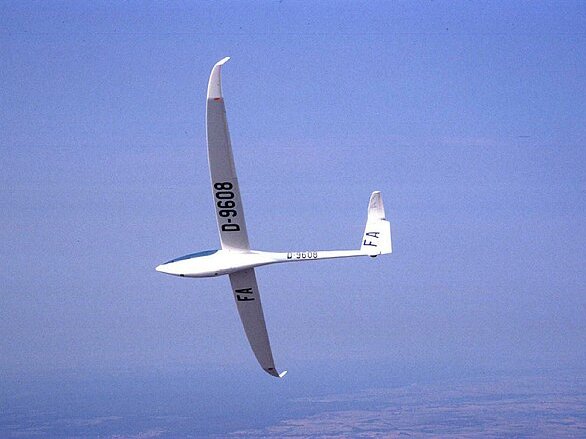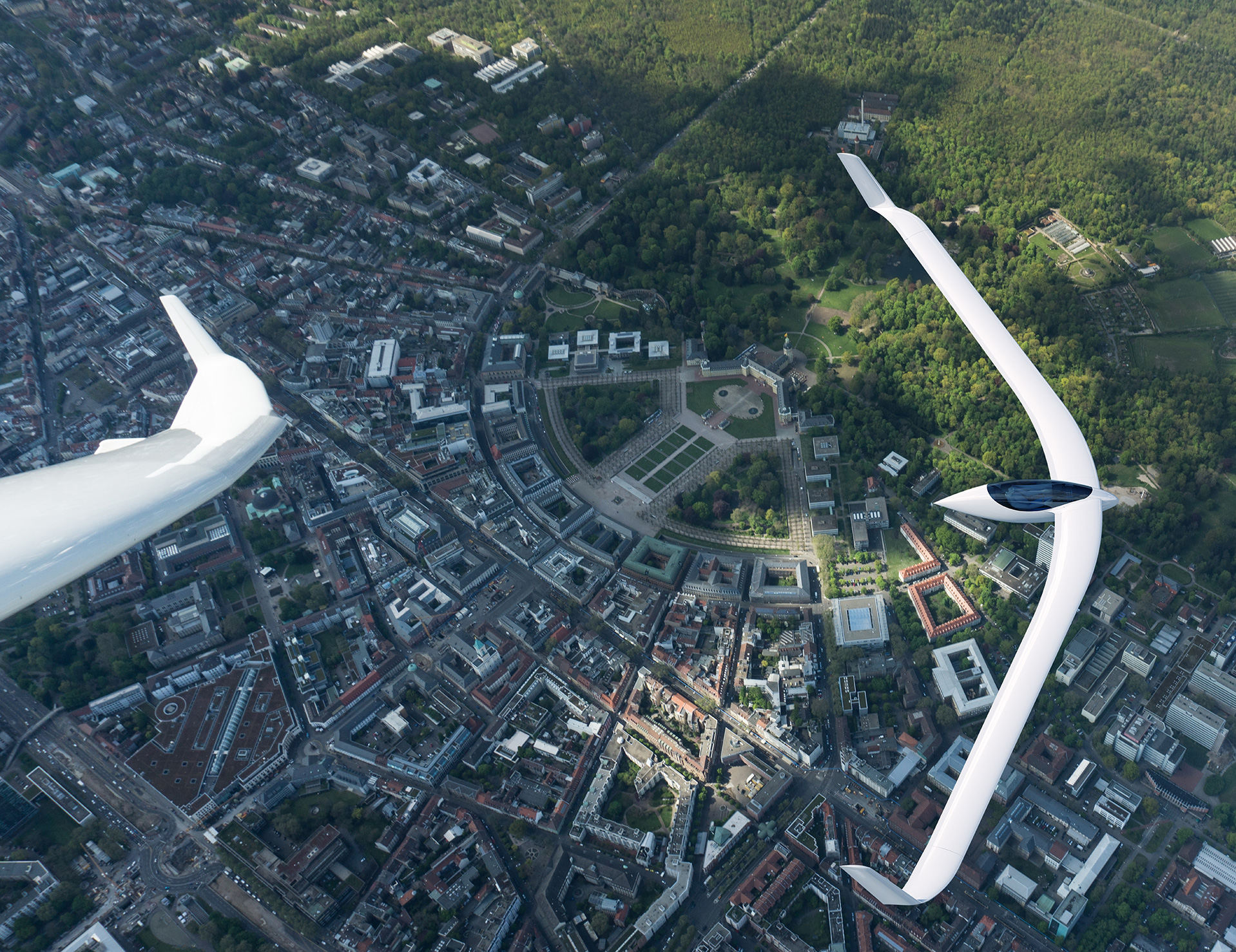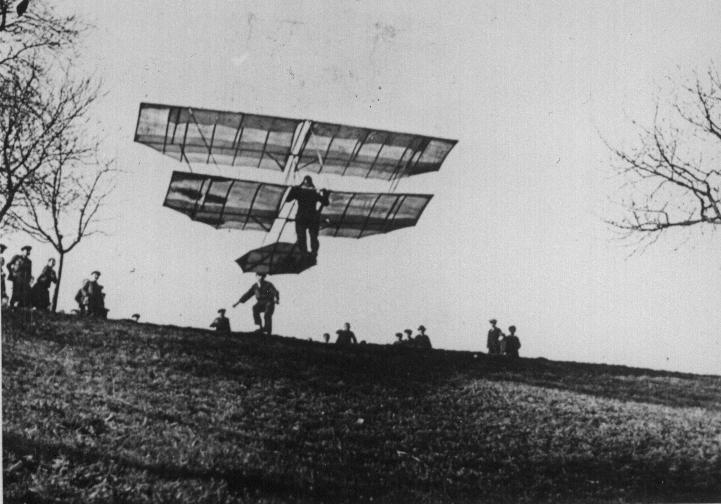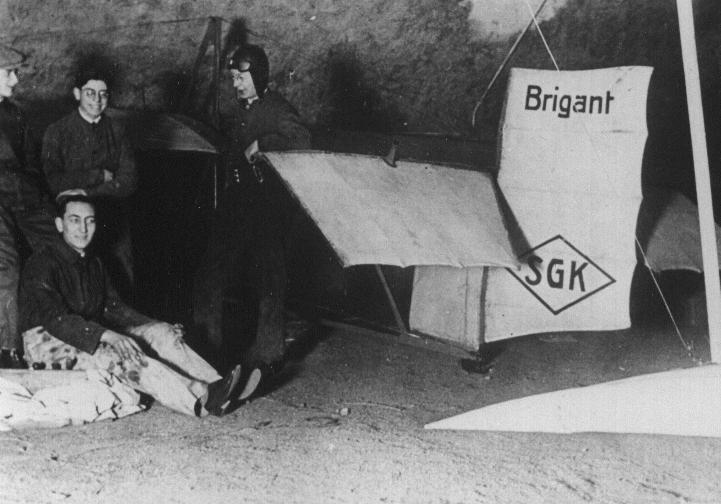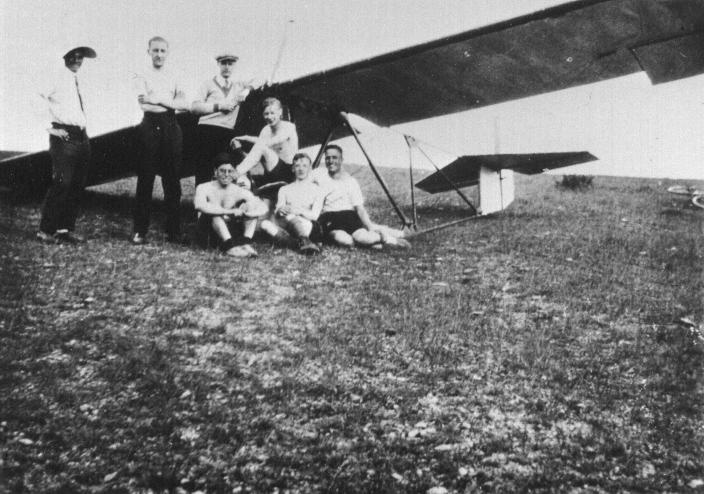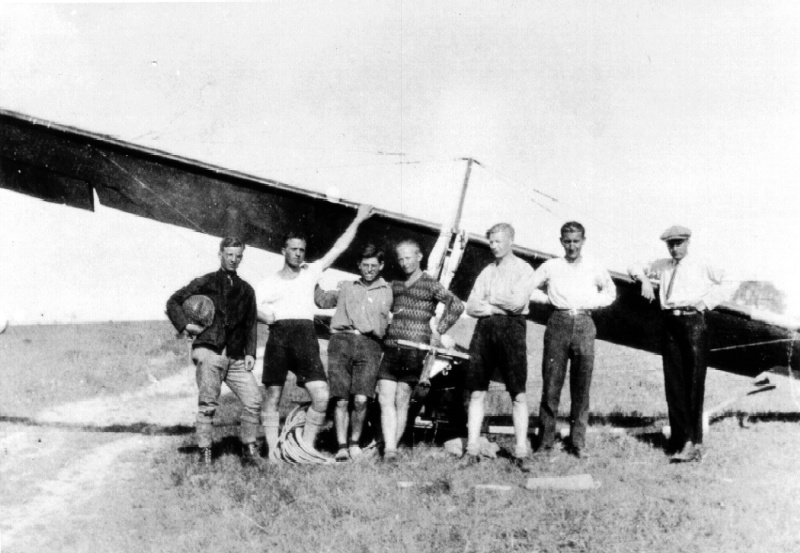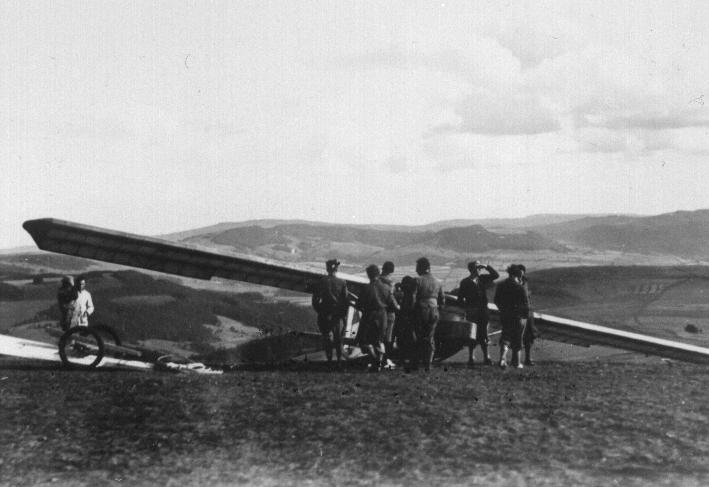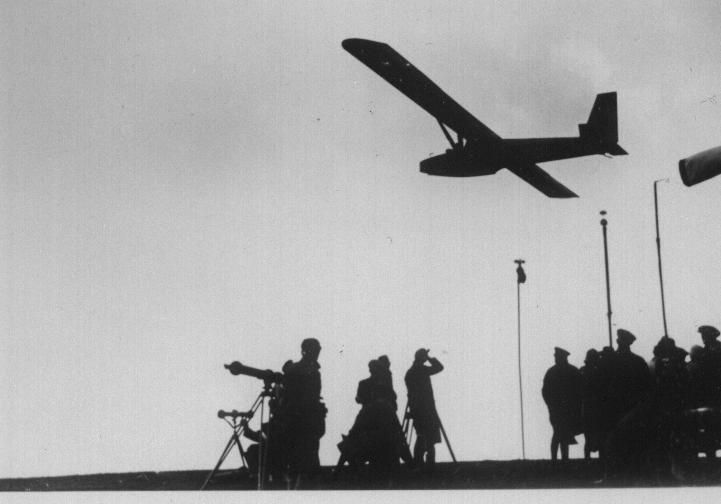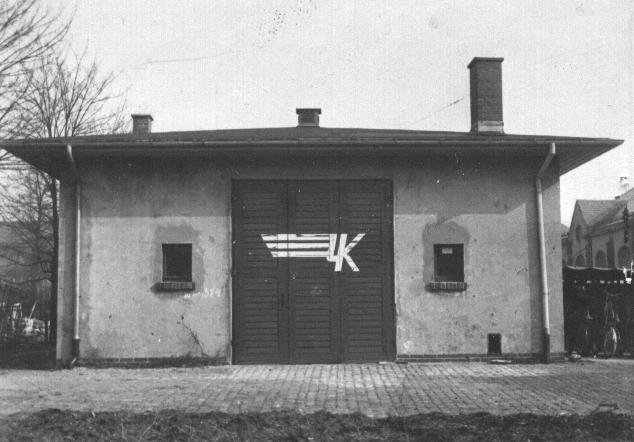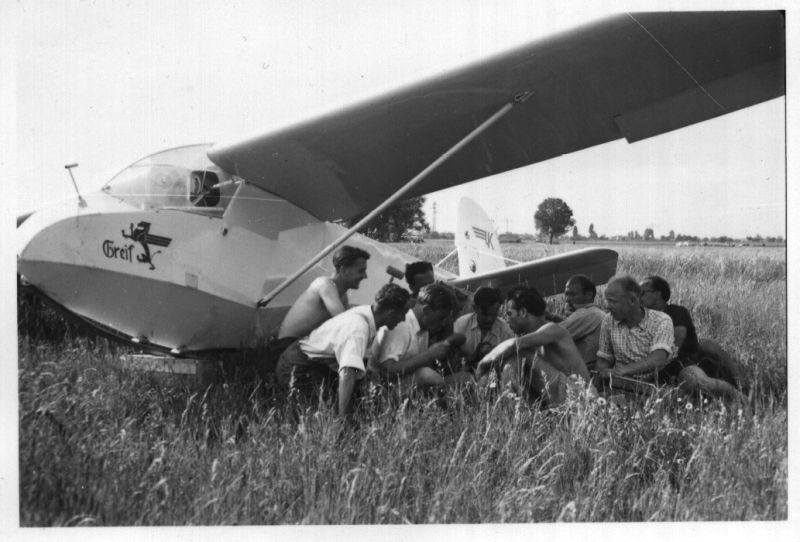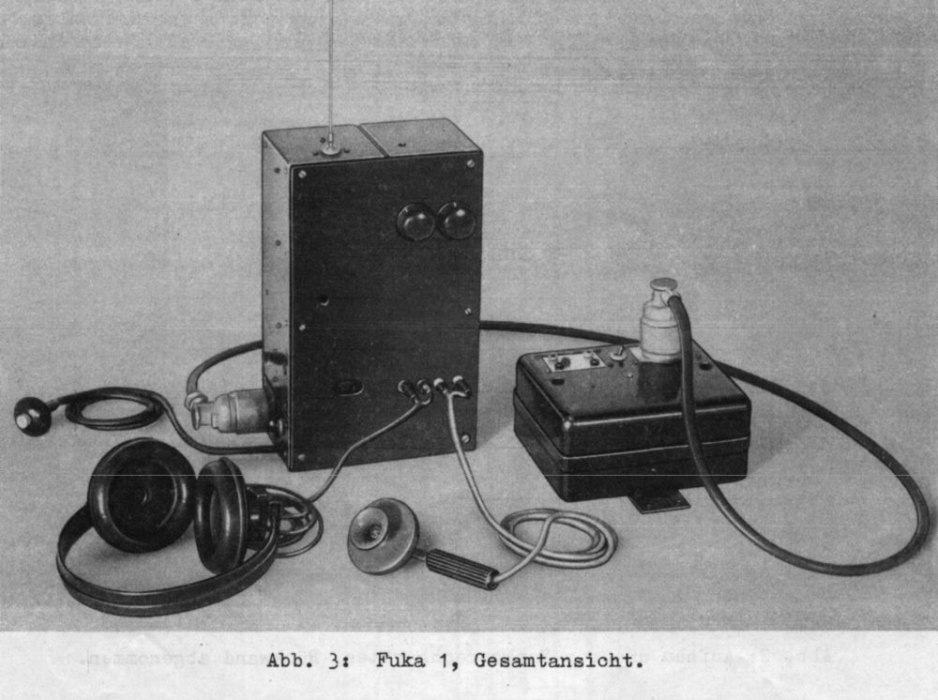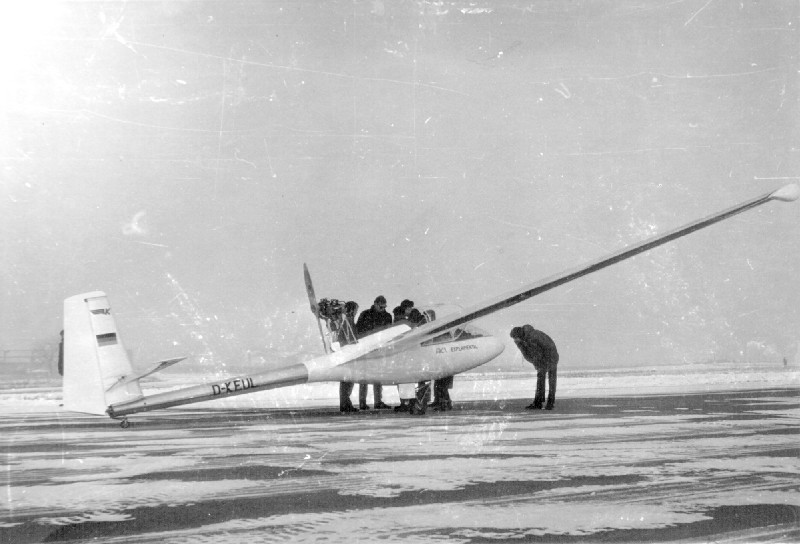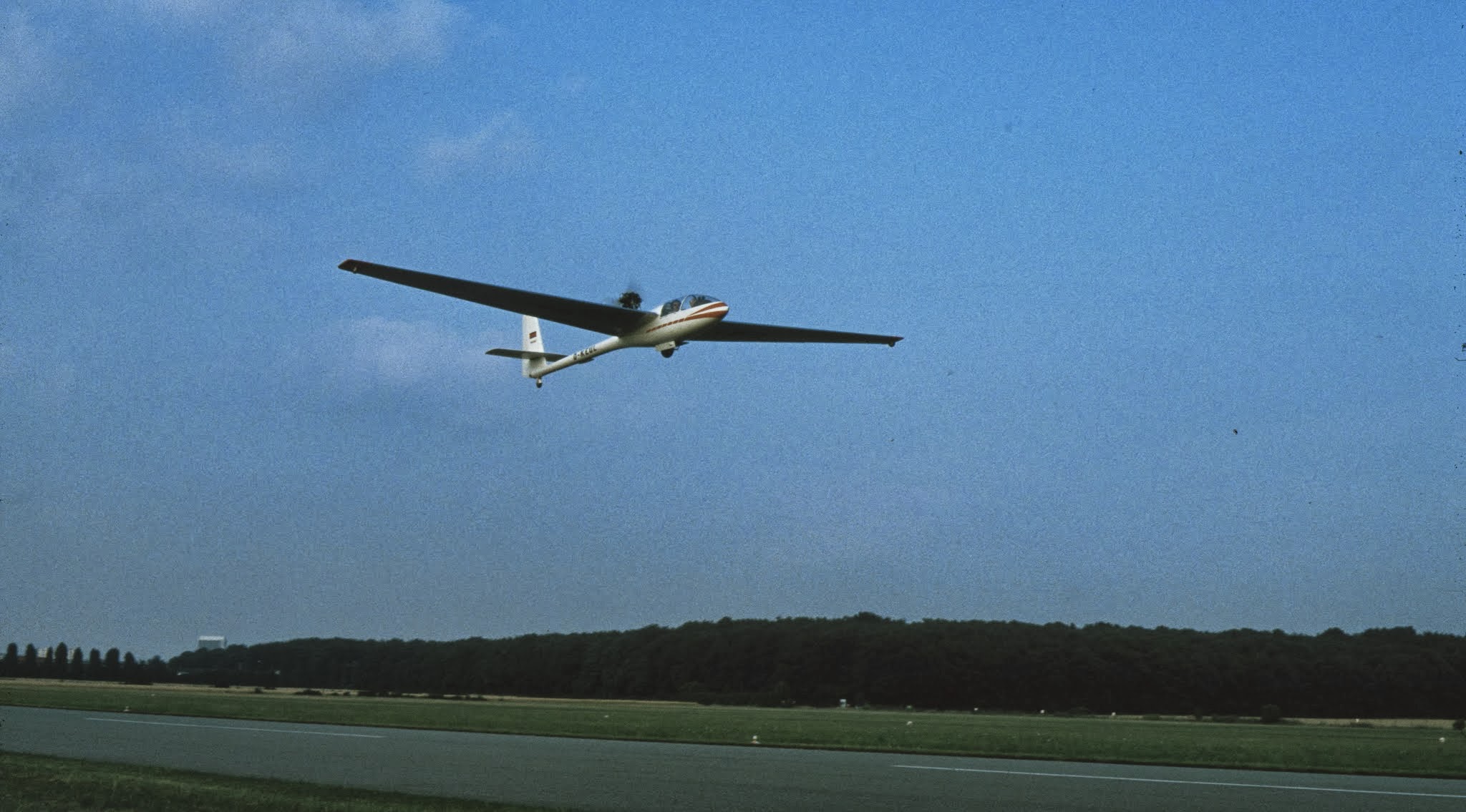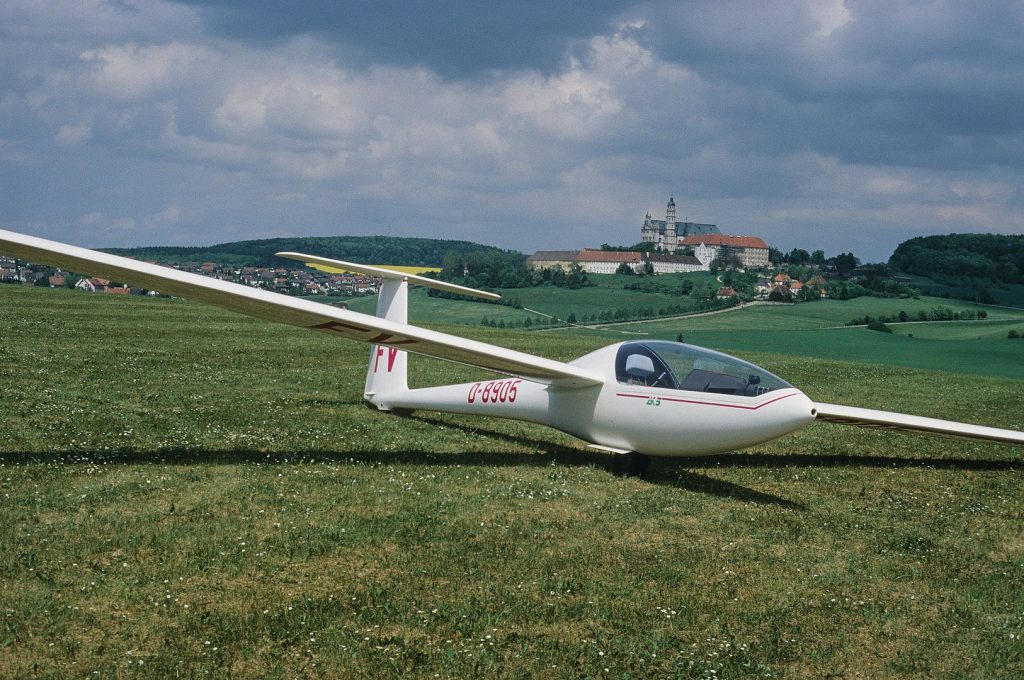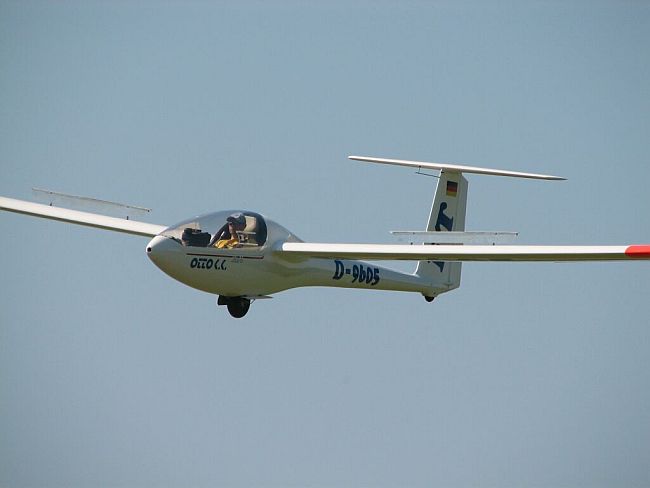History
Pre-war Akaflieg: 1928 – 1933
Founding of “Akademischen Fliegergruppe Karlsruhe”
In the winter semester of 1927/28, some students came together to found a gliding group at the suggestion of Dr.-Ing. Karl Töpfer, assistant to the Chair of Motor Vehicles with a teaching assignment for aircraft technology. This group was entered in the register of associations under the name “Akademische Fliegergruppe Karlsruhe 1928”. From the “Segelfliegergruppe Karlsruhe” (SGK), which had disbanded due to lack of viability, it took over a hang glider (see sequence of pictures below) and a seated glider called “Brigant”.
First Attempts at Flying the Hang-Glider
The first air jumps were made with the hang glider in the Karlsruhe area (especially on a slope near Königsbach in Pfinztal). Soon, however, it was necessary to cover the hang glider with new fabric. A flowered cotton fabric could be purchased at a reasonable price, which gave the glider its future nickname “Bliemchen”. Unfortunately, the “Bliemchen” proved to be a short-lived consumer good. During a rather rough spell of weather, they went out again to a suitable slope. At first, no one really had the courage to take off in the strong wind. But eventually they decided to give it a try. As soon as the glider and pilot were in position for take-off, a strong gust hit the glider, the pilot lost his balance and tipped to one side. The hang glider hit the ground and broke up. “Bliemchen” literally wrapped itself around the pilot’s stomach, and repair was no longer an option.
The “Brigant” seat glider
In addition to poor flight characteristics, the “Brigant” had a particularly serious handicap: the pilot was inside a triangular wooden structure to which the wings were attached. This meant that there was a strut directly in front of the head, which not only obstructed visibility, but also proved to be quite dangerous during hard landings. The Brigant was quickly given the name “Schädelspalter” (skull splitter).
New Destinations – “Zögling” School Glider
The desire arose to build the then newly developed “Zögling” training glider, which was already being used with great success by the Rhön-Rossitten Society. As no suitable gliders were available, there was enough time for workshop work. A basement room in the display building, which was made available to the group by the Technische Hochschule, served as a workshop. Donations in kind and money were collected to finance the work. Once the conditions for the construction had been created, Albert Hofmann, who had passed the A and B exams on the Wasserkuppe, the center of German gliding at the time, procured the plans and materials.
The “Zögling” was completed in May 1928 and the first rubber rope launch took place soon afterwards. By the end of the summer semester, everyone had successfully passed their A exams: Ferdinand Hügel, Albert Künzler, Franz Villinger, Boris Masing, Heinz Häußler, Otto Goebel, on the far right the flight instructor Albert Hofmann (the founding member Bauer is missing).
Now they wanted to go to the Wasserkuppe to do the “B” there, which three Karlsruhe academy pilots also managed to do.
Further Development and Redesign of Gliders
The next goal was to build a “Zögling” with a smaller fuselage, with which a flight time of more than 5 minutes was to be achieved. However, during its first flight in 1929, it broke up while hanging in a tree.
As part of a diploma thesis, one of the Akaflieger, Heinz Prinz, developed an aircraft called the HL28 (high-performance aircraft 1928): With a 20m wingspan, positively swept wings and a co-supporting tailplane, the aircraft was designed to exploit even the weakest updrafts. The thesis was supervised by Dr. Töpfer, who had received the necessary funding from the Karlsruhe University Association.
The plane crashed on its first flight in 1929. The malfunction was attributed to faulty design. After some modifications, another flight attempt was made in the spring of 1930, but the glider stalled again at a height of 4 meters and was damaged again. Thankfully, the pilots emerged from the crashed glider unharmed both times.
After this unsuccessful flight attempt, the unsuitability of the construction was proven and the group refused to spend any more time and work on the HL28.
The cash prize donated in recognition of the clean construction of the “HL28” was used to purchase a ”Hol’s der Teufel“ (Devil take it). The plane from the Schleicher company in Poppenhausen was a light glider with a smaller pilot’s seat. The aircraft had excellent characteristics for training and proved to be advantageous for the “ Karlsruher Hochstartmethode” (Karlsruhe high take-off method). This developed method used a truck with a pulley and a 200 m long steel cable, as well as a rubber cable, which was interposed for damping. Despite the comparatively short rope, heights of up to 120 m could be reached, which made it possible to enter the thermals.
“Karlsruhe” above the Wasserkuppe
The Akademische Fliegergruppe Karlsruhe appeared at the “11th Rhön” in 1930 with the “Karlsruhe.” The following pictures bear witness to the airworthiness of this type and give an idea of the fascination of flying close to the slope.
Motorized Flight in the Akaflieg – The Early Thirties
At the beginning of 1929, the Akaflieg received a request from the Reich Ministry of Transport asking if it would like to have a motorized aircraft. Pleased and surprised by this request, it gratefully accepted the offer and in May 1929 became the happy owner of an L25a sports airplane from Klemm in Böblingen. In April 1931, the Akaflieg received a second aircraft from the Reich Ministry, an L25a with a reinforced airframe and a better engine. However, due to a tragic flying accident for which the Akaflieg’s motorized flight instructor was found guilty in court, training could no longer be continued because flight instructor Grueber did not resume teaching.
However, gliding operations continued with the “’Hol’s der Teufel”.
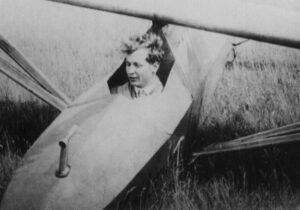
The Akaflieg Karlsruhe appeared at the “12th Rhön” with three aircraft: “Zögling”, “Hol’s der Teufel” and “Karlsruhe.” In 1932, the Karlsruhe team was once again represented at the Wasserkuppe. They purchased a Kassel-25D glider for the flying competition. In contrast to many other owners who suffered breakages that year, the Akaflieg Karlsruhe was able to bring all the gliders home safely. In addition, they were able to take home a cash prize and a no less valuable material prize in the form of plywood.
The development work and flying activities of the Akaflieg were abruptly interrupted in 1933: The Akaflieg was dissolved on May 13, 1933. All the equipment was transferred to the Karlsruhe chapter of the German Air Sports Association.
The Refoundation in 1951

A Second Beginning
After a forced break of 16 years, the name Akaflieg reappeared in the summer of 1949. Initially, the Akaflieger had to work in secret, as all flying activities were initially banned after the war. On May 22, 1951, the new Akademische Fliegergruppe Karlsruhe was officially re-established after the release of gliding. The group already had 78 members on the day it was founded. A preparatory committee was elected, which took over the management of the Akaflieg Karlsruhe until the election of the board. At the general meeting on September 26, 1951, the first board of directors was elected to replace the ‘preparatory committee’.
The first Akaflieg Board after the War:
First Chairman: Dipl.-Ing. Otto Schiele
Second Chairman: cand. mach. Werner Uhlig
Clerk: cand. ing. Franz Pieper
Treasurer: cand. chem. Friedel Wasmann
The young Akaflieg was given a former gas testing room by the technical college. As there was no member of the group at the time who could guarantee the proper construction of an airplane, work began on the design and construction of a towing winch and a transport trolley. As machine tools that had been loaned out in the meantime were needed again by their owners, a lot of work had to be carried out in external workshops.
In the Early Summer of 1952, the Dream of Flying becomes Reality Again
The launch winch was also completed at the same time. From July to November 1952, 600 launches were carried out, with an average of one cable break every 46 launches. The first flying season ended with a successful ceremony. On December 4, 1952, the Doppelraab was christened “Greif” by Professor Haupt on the occasion of the handover of the rectorate at the University of Karlsruhe in the presence of many guests.
In 1953, “Fuka1”, an aircraft radio specially developed for gliding, was presented.
Fuka1, developed in collaboration with the Department of Theoretical Electrical Engineering and Low Current Technology, was awarded a prize at the technical competition of the German Gliding Championships in Oerlinghausen and classified as “worthy of development”. The Karlsruhe University Association also honored the development with a generous sum of money. However, the final approval of this device was later rejected by the Federal Institute for Air Traffic Control on the grounds that the receiver was not crystal-controlled and its distortion factor was too high.
The Glider Fleet is Growing
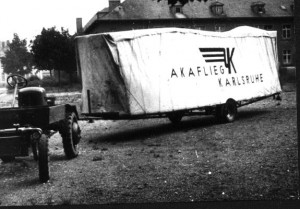 Thanks to the support of numerous friends and patrons, the Akaflieg’s aircraft fleet was quickly expanded: In 1954, a Kranich III performance two-seater was acquired and christened “Walter”. In 1955, a new Doppelraab V6 “Studiosus” and a Bücker 181 Bestmann motor plane were added to the fleet. A home-built L-Spatz 55 completed the Akaflieg fleet at the time. To improve workshop supervision and coordination, the aircraft builder Fritz Horn was appointed in April 1954. He had the dual function of workshop manager and flight instructor.
Thanks to the support of numerous friends and patrons, the Akaflieg’s aircraft fleet was quickly expanded: In 1954, a Kranich III performance two-seater was acquired and christened “Walter”. In 1955, a new Doppelraab V6 “Studiosus” and a Bücker 181 Bestmann motor plane were added to the fleet. A home-built L-Spatz 55 completed the Akaflieg fleet at the time. To improve workshop supervision and coordination, the aircraft builder Fritz Horn was appointed in April 1954. He had the dual function of workshop manager and flight instructor.
On January 28, 1956, the Altherrenschaft was introduced to ensure that contact with the Akaflieg could continue after graduation.
At the beginning of the 1960s, the focus was on planning a new Akaflieg workshop. Both the old workshop and the hangar on the Westhochschule Campus were only suitable for our work to a limited extent and had therefore only ever been a temporary solution. In 1965, the conversion of the former “Lichthalle” on the grounds of the Westhochschule for the purposes of the Akaflieg finally began. In the same year, the Klemm 107B, the Akaflieg’s previous motorized aircraft, was replaced by a Bölkow 207. Honorary member and rector Prof. Krämer christens it “Fridericiana.”
The new workshop opened up completely new possibilities, the winter maintenance of the aircraft could be carried out much more easily, aircraft projects could be planned and finally implemented. After extensive research into winch launching, work began on the AK-1 project in the mid-1960s.
On January 9, 1971 at 12:31 CET, the AK-1 took to the air for the first time in a self-launch. The first Akaflieg Karlsruhe prototype after the war had proven its suitability. The AK-1 is regarded as a pioneer of retractable engine technology, which is used today in many gliders with auxiliary power units. It served faithfully until October 18, 2008. It was then handed over to the Deutschen Museum, where it can be admired as an exhibit.
The 70s and 80s
In the early 1970s, flight testing of the AK-1 took priority. One or two improvements could still be integrated into the system. The ceremonial christening took place on July 7, 1973. Prof. Dr. Max Diem poured liquid air over the AK-1 and gave it the name “Mischl”, which was intended to express the fact that the AK-1 was a hybrid between a motor and a glider.
On October 27, 1973, the general meeting made a decision regarding the AK-1 successor project: a high-performance motor glider, preferably of plastic construction.
The various development goals, difficulties and ultimately the failure of the AK-2 project are described on the project page.
In 1975, Akaflieg purchased a Standard Cirrus as the first glider in plastic construction, and a new generation of gliders was born.
Development of Avionics
Parallel to the work on the AK-2, the Akaflieg Karlsruhe had been working on the design and construction of flight data computers for gliding since the early 1970s. The result of these efforts was the AK-3 electric variometer with target speed sensor, which even went into production in a small series. Under the name AK-3R, the desired goal was finally achieved: a final approach computer could be integrated into the now proven AK-3 variometer system.
Under the project name AK-4, cooperation with the Institute for Meteorology and Climate Research was intensified: A data acquisition system was designed, built and successfully deployed for climate measurements above the Upper Rhine using powered aircraft.
Launch-Winch AFK-3
Construction of the AFK-3 began in 1983. Following the introduction of plastic two-seaters, the performance of the AFK-2 was no longer sufficient. Work was completed in 1987 and the winch was put into operation.
AK-5
In 1984, the next prototype project was also to be tackled. The AK-5 is a 15m standard class aircraft in fiber composite construction.
The 90s
At the beginning of the 90s, the Akaflieg achieved great success with the first flight of the AK-5. This led directly to the next project, a further development of the AK-5, the AK-5b, which finally took off for the first time on May 26, 1996.
During this time, work was already underway on the next prototype, the AK-8, a high-performance single-seater in the standard class, which began construction in 1996 and made its official maiden flight in 2003.
New Projects
After the AK-8, a new project had to be found. Two projects emerged. One was the installation of a turbine instead of a regular auxiliary power unit, which was given the project title AK-9.
In 2010, work also began on the development of the AK-X, a flying wing glider, which is expected to deliver a significant increase in performance compared to conventional gliders. You can find out about the progress of the project here in our blog (German language).
